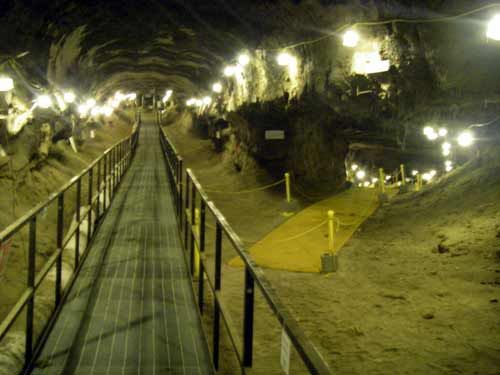There are few places in the world where you are allowed to hold something that is 15,000-25,000 years old. Fossils can be older than this and you might have a rare opportunity to handle one, but they have gone through a change since the death of the animal. Those old bones have been fossilized. They are now rocks, fossils.
In contrast, I had the rare opportunity to visit a permafrost tunnel near Fairbanks, Alaska. A tunnel dug into the side of a hill into the permafrost down about 45 meters. As we descended into the tunnel we traveled back into history 40,000 years.
 Owned by the U.S. Corp of Engineers, this tunnel into Hill 456 near Fairbanks, Alaska is a 360 feet in length decending 40,000 years.
Owned by the U.S. Corp of Engineers, this tunnel into Hill 456 near Fairbanks, Alaska is a 360 feet in length decending 40,000 years.
With each step we moved thousands of years into the permafrost. Permafrost is permanently frozen ground. So do you know why it is here?
I held bones that had fallen from the walls only days earlier. Bones of a long horned steppe bison a Pleistocene mammal that died 15,000 years ago and whose scattered bones were frozen into the permafrost to remain untouched for thousands of years until they ended up cradled in my hands. THIS WAS INCREDIBLE!!!
 Gary holds a jaw bone of a steppe bison that has survived fozen since the last Ice Age.
Gary holds a jaw bone of a steppe bison that has survived fozen since the last Ice Age.
I saw roots and branches of plants that looked like the specimens just outside but had been buried for 20,000 years and were in perfect condition. From where I stood they looked alive.
 The bacteria in this ice wedge date back 10s of thousands of years.
The bacteria in this ice wedge date back 10s of thousands of years.
Huge ice wedges, water that had filtered into the permafrost and froze, have been radiocarbon dated to be 25,000 years old. By radiocarbon dating the bacteria that had been permanently frozen so long ago we learn about the history of our world. The data collected from a tunnel like this may provide insight into global climate change.
Global climate change, how is that affecting the permafrost? Well, in parts of the arctic the permafrost is melting. This melting is releasing carbon that had been trapped in the permafrost but is now adding to the level of greenhouse gases in our atmosphere.
Global climate change, this is a major reason for the research occurring in the polar regions of our planet. The CReSIS project utilizing the Unmanned Air Vehicle (UAV) named Meridian will be studying the Ice sheets of Antarctica.
 The Meridian an Unmanned Air Vehicle designed by CReSIS
The Meridian an Unmanned Air Vehicle designed by CReSIS
What can data collected by Meridian show us, the scientific community of the world, about the changes in our global climate?
Hope to hear your ideas soon,
Gary

